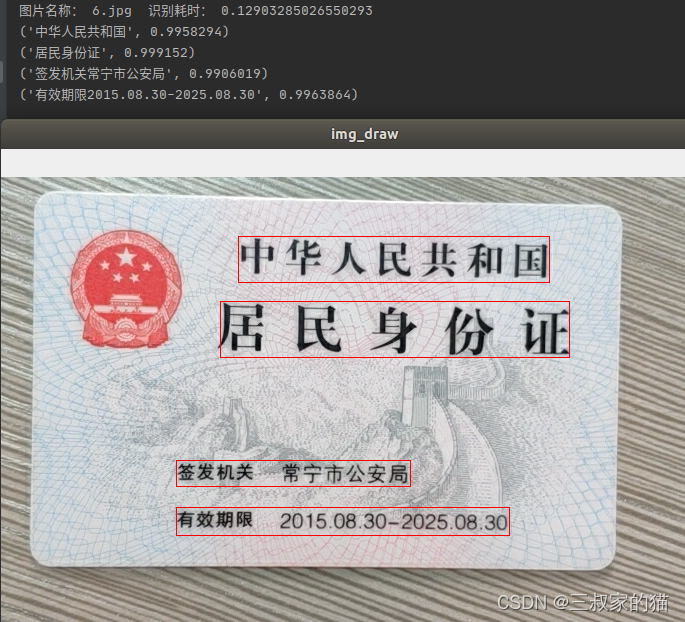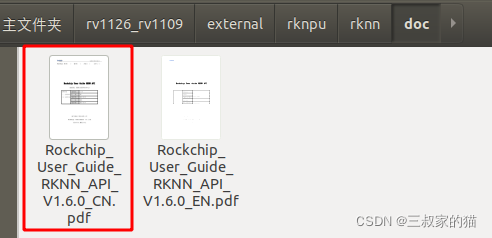序言
本篇接上一篇,主要是一些代码实现。
一、onnx模型测试代码(python)
用于测试所提供的onnx模型文件在没转换时的推理效果:
import os
import sys
import cv2
import time
import onnx
import math
import copy
import onnxruntime
import numpy as np
import pyclipper
from shapely.geometry import Polygon
# PalldeOCR 检测模块 需要用到的图片预处理类
class NormalizeImage(object):
""" normalize image such as substract mean, divide std
"""
def __init__(self, scale=None, mean=None, std=None, order='chw', **kwargs):
if isinstance(scale, str):
scale = eval(scale)
self.scale = np.float32(scale if scale is not None else 1.0 / 255.0)
mean = mean if mean is not None else [0.485, 0.456, 0.406]
std = std if std is not None else [0.229, 0.224, 0.225]
shape = (3, 1, 1) if order == 'chw' else (1, 1, 3)
self.mean = np.array(mean).reshape(shape).astype('float32')
self.std = np.array(std).reshape(shape).astype('float32')
def __call__(self, data):
img = data['image']
from PIL import Image
if isinstance(img, Image.Image):
img = np.array(img)
assert isinstance(img,
np.ndarray), "invalid input 'img' in NormalizeImage"
data['image'] = (
img.astype('float32') * self.scale - self.mean) / self.std
return data
class ToCHWImage(object):
""" convert hwc image to chw image
"""
def __init__(self, **kwargs):
pass
def __call__(self, data):
img = data['image']
from PIL import Image
if isinstance(img, Image.Image):
img = np.array(img)
data['image'] = img.transpose((2, 0, 1))
return data
class KeepKeys(object):
def __init__(self, keep_keys, **kwargs):
self.keep_keys = keep_keys
def __call__(self, data):
data_list = []
for key in self.keep_keys:
data_list.append(data[key])
return data_list
class DetResizeForTest(object):
def __init__(self, **kwargs):
super(DetResizeForTest, self).__init__()
self.resize_type = 0
self.limit_side_len = kwargs['limit_side_len']
self.limit_type = kwargs.get('limit_type', 'min')
def __call__(self, data):
img = data['image']
src_h, src_w, _ = img.shape
img, [ratio_h, ratio_w] = self.resize_image_type0(img)
data['image'] = img
data['shape'] = np.array([src_h, src_w, ratio_h, ratio_w])
return data
def resize_image_type0(self, img):
"""
resize image to a size multiple of 32 which is required by the network
args:
img(array): array with shape [h, w, c]
return(tuple):
img, (ratio_h, ratio_w)
"""
limit_side_len = self.limit_side_len
h, w, _ = img.shape
# limit the max side
if max(h, w) > limit_side_len:
if h > w:
ratio = float(limit_side_len) / h
else:
ratio = float(limit_side_len) / w
else:
ratio = 1.
resize_h = int(h * ratio)
resize_w = int(w * ratio)
resize_h = int(round(resize_h / 32) * 32)
resize_w = int(round(resize_w / 32) * 32)
try:
if int(resize_w) <= 0 or int(resize_h) <= 0:
return None, (None, None)
img = cv2.resize(img, (int(resize_w), int(resize_h)))
except:
print(img.shape, resize_w, resize_h)
sys.exit(0)
ratio_h = resize_h / float(h)
ratio_w = resize_w / float(w)
# return img, np.array([h, w])
return img, [ratio_h, ratio_w]
### 检测结果后处理过程(得到检测框)
class DBPostProcess(object):
"""
The post process for Differentiable Binarization (DB).
"""
def __init__(self,
thresh=0.3,
box_thresh=0.7,
max_candidates=1000,
unclip_ratio=2.0,
use_dilation=False,
**kwargs):
self.thresh = thresh
self.box_thresh = box_thresh
self.max_candidates = max_candidates
self.unclip_ratio = unclip_ratio
self.min_size = 3
self.dilation_kernel = None if not use_dilation else np.array(
[[1, 1], [1, 1]])
def boxes_from_bitmap(self, pred, _bitmap, dest_width, dest_height):
'''
_bitmap: single map with shape (1, H, W),
whose values are binarized as {0, 1}
'''
bitmap = _bitmap
height, width = bitmap.shape
outs = cv2.findContours((bitmap * 255).astype(np.uint8), cv2.RETR_LIST,
cv2.CHAIN_APPROX_SIMPLE)
if len(outs) == 3:
img, contours, _ = outs[0], outs[1], outs[2]
elif len(outs) == 2:
contours, _ = outs[0], outs[1]
num_contours = min(len(contours), self.max_candidates)
boxes = []
scores = []
for index in range(num_contours):
contour = contours[index]
points, sside = self.get_mini_boxes(contour)
if sside < self.min_size:
continue
points = np.array(points)
score = self.box_score_fast(pred, points.reshape(-1, 2))
if self.box_thresh > score:
continue
box = self.unclip(points).reshape(-1, 1, 2)
box, sside = self.get_mini_boxes(box)
if sside < self.min_size + 2:
continue
box = np.array(box)
box[:, 0] = np.clip(
np.round(box[:, 0] / width * dest_width), 0, dest_width)
box[:, 1] = np.clip(
np.round(box[:, 1] / height * dest_height), 0, dest_height)
boxes.append(box.astype(np.int16))
scores.append(score)
return np.array(boxes, dtype=np.int16), scores
def unclip(self, box):
unclip_ratio = self.unclip_ratio
poly = Polygon(box)
distance = poly.area * unclip_ratio / poly.length
offset = pyclipper.PyclipperOffset()
offset.AddPath(box, pyclipper.JT_ROUND, pyclipper.ET_CLOSEDPOLYGON)
expanded = np.array(offset.Execute(distance))
return expanded
def get_mini_boxes(self, contour):
bounding_box = cv2.minAreaRect(contour)
points = sorted(list(cv2.boxPoints(bounding_box)), key=lambda x: x[0])
index_1, index_2, index_3, index_4 = 0, 1, 2, 3
if points[1][1] > points[0][1]:
index_1 = 0
index_4 = 1
else:
index_1 = 1
index_4 = 0
if points[3][1] > points[2][1]:
index_2 = 2
index_3 = 3
else:
index_2 = 3
index_3 = 2
box = [
points[index_1], points[index_2], points[index_3], points[index_4]
]
return box, min(bounding_box[1])
def box_score_fast(self, bitmap, _box):
h, w = bitmap.shape[:2]
box = _box.copy()
xmin = np.clip(np.floor(box[:, 0].min()).astype(np.int), 0, w - 1)
xmax = np.clip(np.ceil(box[:, 0].max()).astype(np.int), 0, w - 1)
ymin = np.clip(np.floor(box[:, 1].min()).astype(np.int), 0, h - 1)
ymax = np.clip(np.ceil(box[:, 1].max()).astype(np.int), 0, h - 1)
mask = np.zeros((ymax - ymin + 1, xmax - xmin + 1), dtype=np.uint8)
box[:, 0] = box[:, 0] - xmin
box[:, 1] = box[:, 1] - ymin
cv2.fillPoly(mask, box.reshape(1, -1, 2).astype(np.int32), 1)
return cv2.mean(bitmap[ymin:ymax + 1, xmin:xmax + 1], mask)[0]
def __call__(self, outs_dict, shape_list):
pred = outs_dict
pred = pred[:, 0, :, :]
segmentation = pred > self.thresh
boxes_batch = []
for batch_index in range(pred.shape[0]):
src_h, src_w, ratio_h, ratio_w = shape_list[batch_index] # 图片缩放比例
if self.dilation_kernel is not None:
mask = cv2.dilate(
np.array(segmentation[batch_index]).astype(np.uint8),
self.dilation_kernel)
else:
mask = segmentation[batch_index]
boxes, scores = self.boxes_from_bitmap(pred[batch_index], mask,
src_w, src_h)
boxes_batch.append({
'points': boxes})
return boxes_batch
## 根据推理结果解码识别结果
class process_pred(object):
def __init__(self, character_dict_path=None, character_type='ch', use_space_char=False):
self.character_str = ''
with open(character_dict_path, 'rb') as fin:
lines = fin.readlines()
for line in lines:
line = line.decode('utf-8').strip('\n').strip('\r\n')
self.character_str += line
if use_space_char:
self.character_str += ' '
dict_character = list(self.character_str)
dict_character = self.add_special_char(dict_character)
self.dict = {
}
for i, char in enumerate(dict_character):
self.dict[char] = i
self.character = dict_character
def add_special_char(self, dict_character):
dict_character = ['blank'] + dict_character
return dict_character
def decode(self, text_index, text_prob=None, is_remove_duplicate=False):
result_list = []
ignored_tokens = [0]
batch_size = len(text_index)
for batch_idx in range(batch_size):
char_list = []
conf_list = []
for idx in range(len(text_index[batch_idx])):
if text_index[batch_idx][idx] in ignored_tokens:
continue
if is_remove_duplicate:
if idx > 0 and text_index[batch_idx][idx - 1] == text_index[batch_idx][idx]:
continue
char_list.append(self.character[int(text_index[batch_idx][idx])])
if text_prob is not None:
conf_list.append(text_prob[batch_idx][idx])
else:
conf_list.append(1)
text = ''.join(char_list)
result_list.append((text, np.mean(conf_list)))
return result_list
def __call__(self, preds, label=None):
if not isinstance(preds, np.ndarray):
preds = np.array(preds)
preds_idx = preds.argmax(axis=2)
preds_prob = preds.max(axis=2)
text = self.decode(preds_idx, preds_prob, is_remove_duplicate=True)
if label is None:
return text
label = self.decode(label)
return text, label
class det_rec_functions(object):
def __init__(self, image,det_path,rec_path,keys_path):
self.img = image.copy()
self.det_file = det_path
self.small_rec_file = rec_path
self.onet_det_session = onnxruntime.InferenceSession(self.det_file)
self.onet_rec_session = onnxruntime.InferenceSession(self.small_rec_file)
self.infer_before_process_op, self.det_re_process_op = self.get_process()
self.postprocess_op = process_pred(keys_path, 'ch', True)
## 图片预处理过程
def transform(self, data, ops=None):
""" transform """
if ops is None:
ops = []
for op in ops:
data = op(data)
if data is None:
return None
return data
def create_operators(self, op_param_list, global_config=None):
"""
create operators based on the config
Args:
params(list): a dict list, used to create some operators
"""
assert isinstance(op_param_list, list), ('operator config should be a list')
ops = []
for operator in op_param_list:
assert isinstance(operator,
dict) and len(operator) == 1, "yaml format error"
op_name = list(operator)[0]
param = {
} if operator[op_name] is None else operator[op_name]
if global_config is not None:
param.update(global_config)
op = eval(op_name)(**param)
ops.append(op)
return ops
### 检测框的后处理
def order_points_clockwise(self, pts):
"""
reference from: https://github.com/jrosebr1/imutils/blob/master/imutils/perspective.py
# sort the points based on their x-coordinates
"""
xSorted = pts[np.argsort(pts[:, 0]), :]
# grab the left-most and right-most points from the sorted
# x-roodinate points
leftMost = xSorted[:2, :]
rightMost = xSorted[2:, :]
# now, sort the left-most coordinates according to their
# y-coordinates so we can grab the top-left and bottom-left
# points, respectively
leftMost = leftMost[np.argsort(leftMost[:, 1]), :]
(tl, bl) = leftMost
rightMost = rightMost[np.argsort(rightMost[:, 1]), :]
(tr, br) = rightMost
rect = np.array([tl, tr, br, bl], dtype="float32")
return rect
def clip_det_res(self, points, img_height, img_width):
for pno in range(points.shape[0]):
points[pno, 0] = int(min(max(points[pno, 0], 0), img_width - 1))
points[pno, 1] = int(min(max(points[pno, 1], 0), img_height - 1))
return points
def filter_tag_det_res(self, dt_boxes, image_shape):
img_height, img_width = image_shape[0:2]
dt_boxes_new = []
for box in dt_boxes:
box = self.order_points_clockwise(box)
box = self.clip_det_res(box, img_height, img_width)
rect_width = int(np.linalg.norm(box[0] - box[1]))
rect_height = int(np.linalg.norm(box[0] - box[3]))
if rect_width <= 3 or rect_height <= 3:
continue
dt_boxes_new.append(box)
dt_boxes = np.array(dt_boxes_new)
return dt_boxes
### 定义图片前处理过程,和检测结果后处理过程
def get_process(self):
det_db_thresh = 0.3
det_db_box_thresh = 0.5
max_candidates = 2000
unclip_ratio = 1.6
use_dilation = True
pre_process_list = [{
'DetResizeForTest': {
'limit_side_len': 2500,
'limit_type': 'max'
}
}, {
'NormalizeImage': {
'std': [0.5, 0.5, 0.5],
'mean': [0.5, 0.5, 0.5],
'scale': '1./255.',
'order': 'hwc'
}
}, {
'ToCHWImage': None
}, {
'KeepKeys': {
'keep_keys': ['image', 'shape']
}
}]
infer_before_process_op = self.create_operators(pre_process_list)
det_re_process_op = DBPostProcess(det_db_thresh, det_db_box_thresh, max_candidates, unclip_ratio, use_dilation)
return infer_before_process_op, det_re_process_op
def sorted_boxes(self, dt_boxes):
"""
Sort text boxes in order from top to bottom, left to right
args:
dt_boxes(array):detected text boxes with shape [4, 2]
return:
sorted boxes(array) with shape [4, 2]
"""
num_boxes = dt_boxes.shape[0]
sorted_boxes = sorted(dt_boxes, key=lambda x: (x[0][1], x[0][0]))
_boxes = list(sorted_boxes)
for i in range(num_boxes - 1):
if abs(_boxes[i + 1][0][1] - _boxes[i][0][1]) < 10 and \
(_boxes[i + 1][0][0] < _boxes[i][0][0]):
tmp = _boxes[i]
_boxes[i] = _boxes[i + 1]
_boxes[i + 1] = tmp
return _boxes
### 图像输入预处理
def resize_norm_img(self, img, max_wh_ratio):
imgC, imgH, imgW = [int(v) for v in "3, 32, 100".split(",")]
assert imgC == img.shape[2]
imgW = int((32 * max_wh_ratio))
h, w = img.shape[:2]
ratio = w / float(h)
if math.ceil(imgH * ratio) > imgW:
resized_w = imgW
else:
resized_w = int(math.ceil(imgH * ratio))
resized_image = cv2.resize(img, (resized_w, imgH))
resized_image = resized_image.astype('float32')
resized_image = resized_image.transpose((2, 0, 1)) / 255
resized_image -= 0.5
resized_image /= 0.5
padding_im = np.zeros((imgC, imgH, imgW), dtype=np.float32)
padding_im[:, :, 0:resized_w] = resized_image
return padding_im
## 推理检测图片中的部分
def get_boxes(self):
img_ori = self.img
img_part = img_ori.copy()
data_part = {
'image': img_part}
data_part = self.transform(data_part, self.infer_before_process_op)
img_part, shape_part_list = data_part
img_part = np.expand_dims(img_part, axis=0)
shape_part_list = np.expand_dims(shape_part_list, axis=0)
inputs_part = {
self.onet_det_session.get_inputs()[0].name: img_part}
outs_part = self.onet_det_session.run(None, inputs_part)
post_res_part = self.det_re_process_op(outs_part[0], shape_part_list)
dt_boxes_part = post_res_part[0]['points']
dt_boxes_part = self.filter_tag_det_res(dt_boxes_part, img_ori.shape)
dt_boxes_part = self.sorted_boxes(dt_boxes_part)
return dt_boxes_part
### 根据bounding box得到单元格图片
def get_rotate_crop_image(self, img, points):
img_crop_width = int(
max(
np.linalg.norm(points[0] - points[1]),
np.linalg.norm(points[2] - points[3])))
img_crop_height = int(
max(
np.linalg.norm(points[0] - points[3]),
np.linalg.norm(points[1] - points[2])))
pts_std = np.float32([[0, 0], [img_crop_width, 0],
[img_crop_width, img_crop_height],
[0, img_crop_height]])
M = cv2.getPerspectiveTransform(points, pts_std)
dst_img = cv2.warpPerspective(
img,
M, (img_crop_width, img_crop_height),
borderMode=cv2.BORDER_REPLICATE,
flags=cv2.INTER_CUBIC)
dst_img_height, dst_img_width = dst_img.shape[0:2]
if dst_img_height * 1.0 / dst_img_width >= 1.5:
dst_img = np.rot90(dst_img)
return dst_img
### 单张图片推理
def get_img_res(self, onnx_model, img, process_op):
h, w = img.shape[:2]
img = self.resize_norm_img(img, w * 1.0 / h)
img = img[np.newaxis, :]
inputs = {
onnx_model.get_inputs()[0].name: img}
outs = onnx_model.run(None, inputs)
result = process_op(outs[0])
return result
def recognition_img(self, dt_boxes):
img_ori = self.img
img = img_ori.copy()
### 识别过程
## 根据bndbox得到小图片
img_list = []
for box in dt_boxes:
tmp_box = copy.deepcopy(box)
cv2.rectangle(img_ori,(int(box[0][0]),int(box[0][1])),(int(box[2][0]),int(box[2][1])),(0,0,255),1)
img_crop = self.get_rotate_crop_image(img, tmp_box)
img_list.append(img_crop)
## 识别小图片
results = []
results_info = []
for pic in img_list:
res = self.get_img_res(self.onet_rec_session, pic, self.postprocess_op)
results.append(res[0])
results_info.append(res)
return results, results_info,img_ori
def draw_bbox(self,img_path, result, color=(255, 0, 0), thickness=2):
import cv2
if isinstance(img_path, str):
img_path = cv2.imread(img_path)
# img_path = cv2.cvtColor(img_path, cv2.COLOR_BGR2RGB)
img_path = img_path.copy()
for point in result:
point = point.astype(int)
cv2.polylines(img_path, [point], True, color, thickness)
return img_path
if __name__=='__main__':
import os
img_path = "./idcard" # 识别测试文件夹
det_file = './model/det_d.onnx' # 检测模型DBNet地址,需要支持动态输入
rec_file = './model/repvgg_s_d.onnx' # 识别模型,需要支持动态输入
keys_file = './dict/dict_text.txt' # 识别keys文件
for name in os.listdir(img_path):
time1 = time.time()
image = cv2.imread(os.path.join(img_path,name))
# OCR-检测-识别
ocr_sys = det_rec_functions(image,det_file,rec_file,keys_file)
# 得到检测框
dt_boxes = ocr_sys.get_boxes()
# 识别 results: 单纯的识别结果,results_info: 识别结果+置信度
results, results_info,img_draw = ocr_sys.recognition_img(dt_boxes)
time2 = time.time()
print("图片名称: {} 识别耗时: {} ".format(name,time2-time1))
print(results)
print()
cv2.imshow("img_draw", img_draw)
cv2.waitKey()
该段代码需要注意的是,onnx模型仅支持动态输入,所以在测试模型时需要转成动态纬度,转换代码如下:
import onnx
file_path = 'weights/det_new.onnx'
model = onnx.load(file_path)
model.graph.input[0].type.tensor_type.shape.dim[0].dim_param = '?'
model.graph.input[0].type.tensor_type.shape.dim[2].dim_param = '?'
model.graph.input[0].type.tensor_type.shape.dim[3].dim_param = '?'
onnx.save(model, 'weights/det_new_d.onnx')
onnx推理测试结果如下所示:

二、RKNN C++代码编写
部署代码已上传https://gitee.com/third_uncles_cat/rknn_ocr,项目工程代码结构如下:

其中,include头文件和src源文件目录是自己定义的代码文件,librknn_api是调用了rknn的库文件和opencv,librknn_api中的四个文件夹可以在rv1126的sdk文件夹中找到,路径如下,将其拷贝进工程即可,或者写CMakeList.txt时将其路径引用,如果是其他系列的板子,比如rk3328等,将这部分替换成其sdk的rknn库也适用:


然后我新建了一个build.sh文件,用于执行编译,内容如下:
#!/bin/bash
set -e
# for rk1808 aarch64
# GCC_COMPILER=${RK1808_TOOL_CHAIN}/bin/aarch64-linux-gnu
# for rk1806 armhf
# GCC_COMPILER=~/opts/gcc-linaro-6.3.1-2017.05-x86_64_arm-linux-gnueabihf/bin/arm-linux-gnueabihf
# for rv1109/rv1126 armhf
GCC_COMPILER=/home/cai/rv1126_rv1109/prebuilts/gcc/linux-x86/arm/gcc-arm-8.3-2019.03-x86_64-arm-linux-gnueabihf/bin/arm-linux-gnueabihf
ROOT_PWD=$( cd "$( dirname $0 )" && cd -P "$( dirname "$SOURCE" )" && pwd )
# build rockx
BUILD_DIR=${
ROOT_PWD}/build
if [[ ! -d "${BUILD_DIR}" ]]; then
mkdir -p ${
BUILD_DIR}
fi
cd ${
BUILD_DIR}
cmake .. \
-DCMAKE_C_COMPILER=${
GCC_COMPILER}-gcc \
-DCMAKE_CXX_COMPILER=${
GCC_COMPILER}-g++
make -j4
make install
cd -
使用时修改GCC_COMPILER交叉编译工具链路径,终端手动运行./build.sh,编译后成build和install文件夹,编译后的可执行文件在install文件夹中,将其通过adb push 上传到板子运行。
运行结果示例如下,有一些字识别错了,还是没有量化好的问题,精度损失比较严重,原因在于我使用了int8量化,但是repvgg的结构对于int8量化并不好,所以可以尝试使用fp16精度量化,可以使用我给出的onnx再多量化尝试,识别模型虽然推理速度很快,但是除了推理外有一些拷贝操作和for循环操作比较耗时,不过是可以优化的:

经过测试,比较费时的操作并非在推理上,而是一些后处理和内存拷贝操作,其中我们比较关注的是识别模型的耗时,识别模型比较耗时的三部分如下:

其中rknn_run是纯推理部分,这部分即是推理耗时;rknn_outputs_get应该是将数据从npu拷贝的cpu的操作,这部分耗时非常高,第三部分是后处理的for循环。感兴趣的可以分别测试这三部分的耗时程度,再去想想怎么优化。
相关优化文档在sdk中的路径如下,自行查阅:

文档中问题示例:

相关参考:模型在rv1126上跑起来遇到的坑